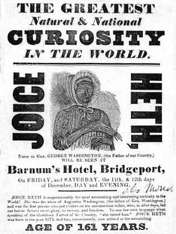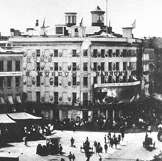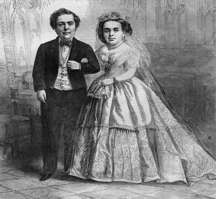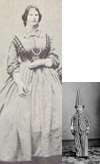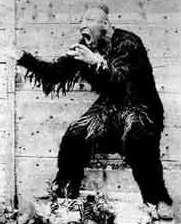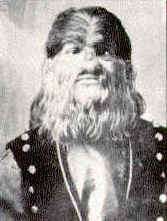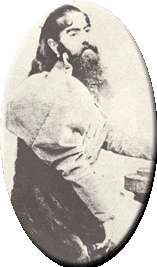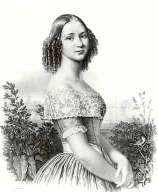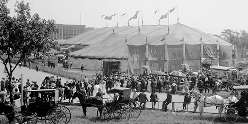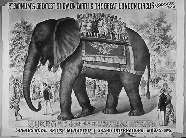|
|
|
 |
|
PT BarnumAmerica's Master Showman and
| |
|
The art of spectacle reached it's zenith during the Gilded Age in America and PT Barnum was it's greatest protagonist. Who said there's a sucker born every minute? Well it wasn't Phineas Taylor (aka PT) Barnum, though that phrase has often been attributed to him. Actually it was said to a reporter by one of Barnum's competitors to explain how Barnum had managed to steal his idea and his audience. Barnum greatly respected his customers and would have been more likely to say there's a "customer" born every minute. He did say "Every crowd has a silver lining," and he spent his entire adult life bringing crowds together so that he could separate them from their silver. |
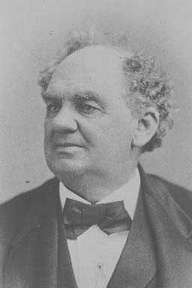
|
|
PT Barnum was the most famous and colorful master showman of 19th century America. In an age when hucksterism and spectacle were the norm, Barnum raised it to a high art. He was often called "The Shakespeare of Advertising" because he believed in the power of advertising and publicity and used it to profit from the public's taste for what he called "Humbug." Barnum called himself the "Prince of Humbugs" because he could deceive people in such a way that they were greatly entertained, even though most of the attractions he promoted didn't even come close to the tremendous buildup he gave them. The master showman was born in Bethel, Connecticut in 1810. His father died when he was fifteen years old and he was left alone to make his own way in the world. Through hard work and pluck he had saved enough by 1829 to start a weekly abolitionist newspaper called The Herald of Freedom. Unfortunately he was soon put out of business after several libel suits and a prosecution which resulted in a short jail term. He moved to New York in 1834, and began his career in show business when he discovered Joice Heth, a woman who claimed to be 161 years old and had once been a slave and a nurse to George Washington. Heth entertained audiences with stories and songs about the young George Washington and drew very large crowds because, as one of Barnum's handbills proclaimed, she "was the first person who put clothes on the unconscious infant, who, in after days, led our heroic fathers on to glory, to victory, and freedom."
As a result of Barnum's campaign to discredit Heth, many people revisited the exhibit to determine for themselves whether they had been duped the first time. "all the while Barnum continued to rake in the cash. Eventually Heth died and Barnum cashed in on her again when he had a public autopsy performed to determine her actual age. It turned out that Heth couldn't have been much more than 80 years old. Barnum declared that he was "shocked" to find out he had been duped. In 1841, Barnum opened the American Museum, located on Broadway in the heart of New York City. It became one of the most famous places of amusement in the entire world, where "500,000 natural and artificial curiosities from every corner of the globe" were on exhibit.
Barnum's Human Menagerie
Charles Stratton was a dwarf who was only 5 years old when Barnum began exhibiting him as General Tom Thumb. He was dressed in costumes imitating Napoleon, Hercules, Samson and many other characters such as a gladiator and a highlander, while he sang, danced, and told jokes.
"The Missing Link" and "Zip the Pinhead" was William Henry Johnson, a black dwarf with a very small head. Though he was born in the US, Barnum claimed he was a member of a previously undiscovered African tribe. He wore a fur-covered ape suit and cavorted about as people threw him coins, which to their great amusement, he threw right back at them.
Feodor Jeftichew was born in St. Petersburg, Russia and suffered from a genetic disorder which caused him to have thick, long hair that covered his entire body. Barnum promoted him as "Jo-Jo, the Dog-Faced Boy" who "looks like a man, barks like a dog and crawls on his belly like a snake."
Josephine "Madame" Clofullia became the most famous bearded lady of the 19th century, thanks to Barnum's talent for promotion. Josephine greatly admired Napoleon III and styled her beard after his.
Constentenus, the Tattooed Man was covered with 388 oriental designs.
Jonathan Bass was a famous ossified man exhibited by Barnum for many years.
Jenny Lind was a Swedish opera singer that Barnum hired to come to the United States in 1850 to give 150 concerts for what was then a princely sum of $1,000 per concert. When she asked Barnum why he hired her before he had even heard her sing,
Barnum retired from show business in 1855, but it wasn't long before financial difficulties forced him to go back to work.
In 1882, Barnum bought a huge elephant by the name of Jumbo from the London Zoo. Jumbo was a sensation when he arrived in New York and later toured around the country in his own custom-made railroad car.
Barnum was 81 when he died in 1891 from heart disease. A couple of weeks prior to his death, he said to reporters that the press never had anything nice to say about someone till after they were dead, so the next day The New York Sun ran his obituary on the front page under the banner "Great And Only Barnum " He Wanted To Read His Obituary " Here It Is." P.T. Barnum wrote in his autobiography titled Struggles and Triumphs, "To me there is no picture so beautiful as smiling, bright-eyed, happy children; no music so sweet as their clear and ringing laughter. That I have had power to provide innocent amusement for the little ones, to create such pictures, to evoke such music, is my proudest reflection." |
|

